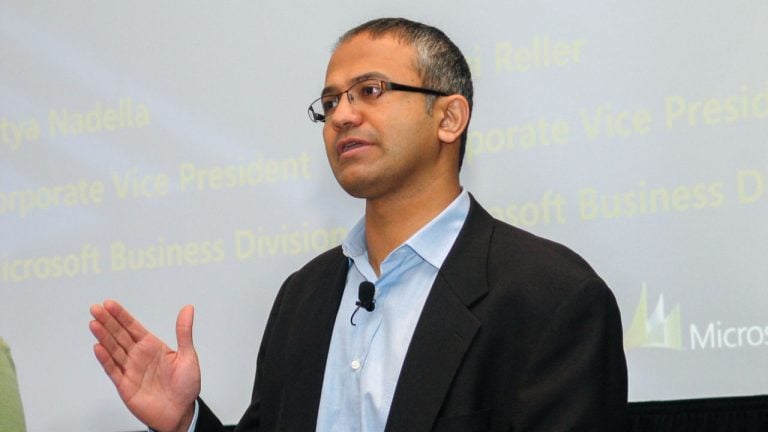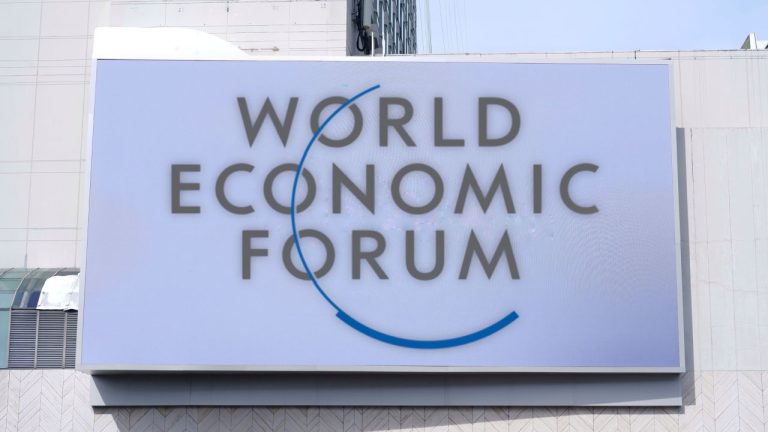
The video showed multiple scenes depicting rows of what appears to be Bitcoin mining rigs, but the cryptocurrency never got a mention.
The World Economic Forum (WEF) showcased the facilities and tech employed by a cryptocurrency mining firm and implied its operations were the “biggest winner” for the environment — but it never actually said it was mining crypto.
Published on April 20, the WEF video promoted efforts toward reducing flaring — where large amounts of gas from oil production or from decomposition are wasted — by the Colorado-based Bitcoin (BTC) miner Crusoe Energy Systems.
Prominent imagery of what appear to be cryptocurrency mining facilities are presented throughout the video; however, the video never directly addresses what is actually happening.

Chase Lochmiller, CEO, and co-founder of Crusoe, explained in the video that it builds and operates “modular data centers” that are co-located with waste energy sources to use wasted methane streams to generate power.
It was noted this enables the production of “ultra-low-cost computing infrastructure” by utilizing stranded energy sources that would otherwise go unused.

The video was noticed by several crypto industry figures.
MicroStrategy co-founder Michael Saylor shared the video with his 3 million Twitter followers on April 23, stating that “even the WEF is recognizing the environmental benefits of Bitcoin Mining.”
Even the @WEF is recognizing the environmental benefits of Bitcoin Mining. pic.twitter.com/kPnMIfyJpU
— Michael Saylor⚡️ (@saylor) April 23, 2023
Meanwhile, Kristine Cranley, a director at the advocacy group the Texas Blockchain Council, pointed out in an April 23 tweet that the video didn't once mention "the b word": Bitcoin.
@WEF promoting mining without using the b word! Source below. Contrast this with the tone of the @nytimes hit piece! Same topic … different emotional experience they are trying to deliver. @NYTimesUp pic.twitter.com/d4OEPkWYFc
— Kristine Cranley (@KristineCranley) April 23, 2023
One user suggested in a tweet that the WEF wasn’t allowed to mention BTC because of their previous “standpoint,” which has included advocacy for changing Bitcoin’s code to proof-of-stake, citing the environmental impact of its current consensus mechanism.
The hidden cost of Bitcoin? Our #environment https://t.co/dF7b2HOkd4 pic.twitter.com/qY5mrmiSaR
— World Economic Forum (@wef) January 15, 2018
Crusoe expanded its Bitcoin mining assets through the acquisition of the operating assets of portable BTC mining operator Great American Mining (GAM) in October 2022.
Related: ExxonMobil is using excess natural gas to power crypto mining: Report
The acquisition added over 10 megawatts (MW) to Crusoe’s mining output, along with approximately 4,000 application-specific integrated circuit (ASIC) crypto-mining rigs.
In June 2022, Crusoe Energy partnered with the government of Oman — a country that exports 21% of its gas production and seeks zero gas flaring by 2030.
Crusoe will open an office in Oman’s capital city of Muscat and install its equipment for capturing gas waste at well sites to use as computing power for crypto mining.
Magazine: Crypto Twitter Hall of Flame: Pro-XRP lawyer John Deaton ‘10x more into BTC, 4x more into ETH
 Investigative journalist James Corbett has recently referred to the ongoing global banking crisis involving SVB, Signature Bank, Credit Suisse and others as the “Panic of 2023,” drawing comparisons to what he views as historical precedents, and pointing ahead to an inevitable and bleak, technocratic surveillance future leveraging central bank digital currencies (CBDCs) should nothing be […]
Investigative journalist James Corbett has recently referred to the ongoing global banking crisis involving SVB, Signature Bank, Credit Suisse and others as the “Panic of 2023,” drawing comparisons to what he views as historical precedents, and pointing ahead to an inevitable and bleak, technocratic surveillance future leveraging central bank digital currencies (CBDCs) should nothing be […] The metaverse is making inroads in job recruiting fronts in Japan. According to local reports, a mega metaverse job fair was organized on Jan. 27, with more than 2,000 students taking part in the experience. The students used avatars to communicate and review the job previews available in different booths controlled by several companies. Japan […]
The metaverse is making inroads in job recruiting fronts in Japan. According to local reports, a mega metaverse job fair was organized on Jan. 27, with more than 2,000 students taking part in the experience. The students used avatars to communicate and review the job previews available in different booths controlled by several companies. Japan […] The latest round of layoffs at Microsoft, which announced it will cut 10,000 jobs this year, has hit key teams for its VR (virtual reality) and metaverse efforts, according to reports. The company will close two projects in these areas, Altspacevr and the Mixed Reality Tool Kit, potentially affecting the progress of Microsoft in these […]
The latest round of layoffs at Microsoft, which announced it will cut 10,000 jobs this year, has hit key teams for its VR (virtual reality) and metaverse efforts, according to reports. The company will close two projects in these areas, Altspacevr and the Mixed Reality Tool Kit, potentially affecting the progress of Microsoft in these […] Satya Nadella, CEO of Microsoft, has given his opinion about the metaverse and the impact that the tech might have in the future. In a conversation with Klaus Schwab, chairman of the World Economic Forum (WEF), Nadella stated that the sense of presence achieved while interacting using metaverse tech is “game-changing.” Microsoft’s Satya Nadella Talks […]
Satya Nadella, CEO of Microsoft, has given his opinion about the metaverse and the impact that the tech might have in the future. In a conversation with Klaus Schwab, chairman of the World Economic Forum (WEF), Nadella stated that the sense of presence achieved while interacting using metaverse tech is “game-changing.” Microsoft’s Satya Nadella Talks […]
A SWIFT-style system for bank-issued and regulated digital currencies was launched by a firm with a tenure building China’s national blockchain project.
A Hong Kong-based blockchain company has launched a digital payments system aimed at bridging the gap between stablecoins and Central Bank Digital Currencies (CBDCs).
Red Date Technology, the blockchain infrastructure firm which is also leading one of China’s blockchain efforts, launched the Universal Digital Payment Network (UDPN) on Jan. 19 during the World Economic Forum (WEF) 2023 meeting in Davos, Switzerland.
According to its whitepaper, the UDPN is a distributed ledger technology (DLT) platform that would serve a similar purpose to what the SWIFT network does for banks, but for stablecoins and CBDCs.
Tech engineering company GFT Technologies and the digital asset creation engine TOKO from law firm DLA Piper are also contributors to UDPN development.
“Just as the SWIFT network created the original common standard for messaging between financial institutions across different settlement systems, the UDPN will serve the same purpose for the emerging generation of CBDCs and stablecoins.”
According to a Jan. 19 press release, a "number of global tier 1 banks" are already involved in use-case proof of concepts (POCs) to test the network in cross-border transfers and swaps.
The release didn’t disclose what banks were taking part in the POCs, but Deutsche Bank, HSBC, Standard Chartered, The Bank of East Asia, and Akbank were represented on a panel at the UDPN launch in Davos.

The stablecoins to be used in the POC were also undisclosed. The networks whitepaper does state, however, that it only supports “CBDCs and regulated fiat-backed stablecoin currency systems as payment methods,” adding:
“No unregulated public-chain crypto-currencies, such as Bitcoin, will be accepted.”
Eight other proof-of-concept tests are scheduled for the network, including issuing and circulating a CBDC and bank-issued stablecoin and using UDPN as a payment gateway for e-commerce.
Related: Going cashless: Norway's digital currency project raises privacy questions
The UDPN has been in development by Red Date for nearly two years.
Before launching this digital payments system, the company was known for its work on Blockchain-based Service Network (BSN), China’s national blockchain project.
In a now-deleted roadmap posted on Jan. 15, 2021, the BSN said it planned to build a global CBDC system that “will completely change the current payment and circulation method, enabling a standardized digital currency transfer method and payment procedure for any information system.”
The latest whitepaper makes no mention of Red Date's tenure in steering China’s blockchain project, nor of the country’s own CBDC efforts with its digital yuan.
Previously, in June 2022 Red Date’s CEO, Yifan He, called cryptocurrencies the “biggest Ponzi scheme in human history.”
 A World Economic Forum (WEF) panel comprised of central bankers and global tech providers has profiled central bank digital currencies (CBDCs) as the future of central bank money, presenting them as one of the solutions for limitations in the payments sector today. However, they have also stated these present several limitations still to be addressed. […]
A World Economic Forum (WEF) panel comprised of central bankers and global tech providers has profiled central bank digital currencies (CBDCs) as the future of central bank money, presenting them as one of the solutions for limitations in the payments sector today. However, they have also stated these present several limitations still to be addressed. […] A group of global banking experts hosted by the World Economic Forum (WEF) convened about the need for global crypto regulation, including stablecoins and unbacked crypto assets. The panel agreed there must be at least some kind of base regulation for these assets and bank-equivalent regulation for blockchain applications seeking to offer products similar to […]
A group of global banking experts hosted by the World Economic Forum (WEF) convened about the need for global crypto regulation, including stablecoins and unbacked crypto assets. The panel agreed there must be at least some kind of base regulation for these assets and bank-equivalent regulation for blockchain applications seeking to offer products similar to […] The World Economic Forum (WEF) has announced the rollout of the Global Collaboration Village, its own metaverse platform, for this year. Klaus Schwab, chairman of the WEF, plans to leverage this representation of Davos to allow people and leaders to meet in virtual worlds and coordinate global collaboration efforts efficiently. WEF to Promote Metaverse-Based Collaboration […]
The World Economic Forum (WEF) has announced the rollout of the Global Collaboration Village, its own metaverse platform, for this year. Klaus Schwab, chairman of the WEF, plans to leverage this representation of Davos to allow people and leaders to meet in virtual worlds and coordinate global collaboration efforts efficiently. WEF to Promote Metaverse-Based Collaboration […]